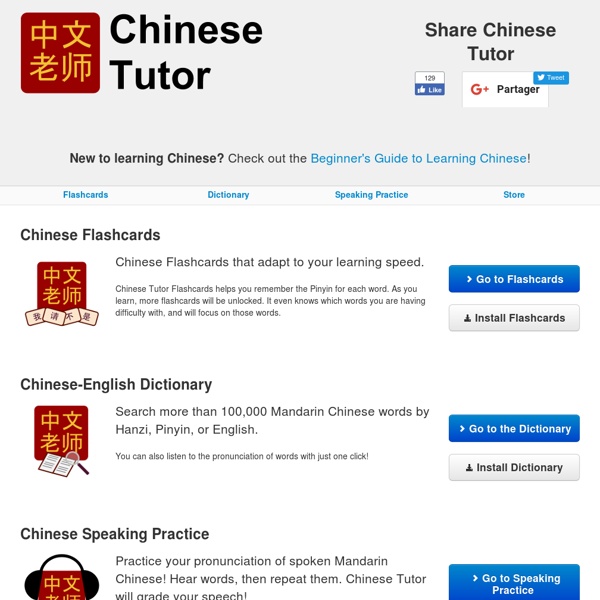



Chinese Grammar Wiki Hacking Chinese - 揭密中文 | Everything you need to know about studying Chinese but no-one will tell you Pinyin Reading: The Witch Doctor of Language Acquisition Author: Robert A. Robles ‘What is the best thing I can do to master the language I’m learning?’ ‘What do you recommend if I need to increase my vocabulary base?’ ‘How can I learn idioms and stop sounding like a language student?’ These are just a few of the questions I’ve fielded as a language instructor in over fifteen years in the classroom. Interesting questions, all of them. It’s not surprising that people of all ages strive to improve on the knowledge they have acquired when studying a second—or third, or fourth—foreign language. And keep doing it for the next six or seven years… At least. How come language learners feel bewildered at the fact that learning a foreign language—and mastering it—will usually take years? Let’s see. First: learning a language produces better results when studying goes hand in hand with becoming familiarized with the culture inherently intertwined with it. Meanwhile, here’s a quirky example for the above: look at the Spanish expression “Mátalas callando.”
China Resources <p><span>If you can see this line, then JavaScript is turned off on your machine and you will not be able to use some features of this site. Please click <a href="../securitywarning.html">here</a> for more information.</span></p> The linked pages have been prepared for use in classes relating to China and may be assigned for direct use on-line if desired. Unless otherwise indicated, these materials were all written by me and may be freely used by teachers and students without additional permission. Click here for a technical note about displaying tone-marked letters and Chinese characters and test page to check your browser's present capabilities. Organization of This Page Other Pages of Links on this Site 1. Historical Texts for Class Discussion Sīmǎ Qiān: The First Emperor of Qín (Qín Shǐ Huángdì 司马迁秦始皇帝) (Anonymous Translation. 2. 3. Confucian & Philosophical Documents for Class Discussion The Great Learning (The shortest volume of the Confucian Canon.) 4. 5. 6. 7. Return to top
Are There Easy Languages and Hard Languages? Are There Easy Languages and Hard Languages? G’day all! I know I don’t ask this question often enough but… How’s your own language learning going? Hopefully you’re staying committed and putting in some serious hours to get the successful outcome you deserve! I’ve now been here in Korea for over 7 months and I’ve gotta say I’m starting to get pretty worn out and in need of a real holiday. I was considering taking time out of my insane schedule to head down to the Philippines for a 1-2 week Tagalog challenge but at this stage I reckon a few days break from any kind of learning and laying on a beach with a fishing rod might be what I really need! This has been a really intense time and I’ve sacrificed a lot of luxuries to hit my fluency mark in Korean up to this point (as I alluded to in this video, spending time exclusively with natives for many months is tougher than you might think). One thing is for sure though – I refuse to leave this place until I can say mission accomplished with Korean.
Chinese phrasebook Mandarin Chinese is the official language of Mainland China and Taiwan, and is one of the official languages of Singapore. In English, it is often just called "Mandarin" or "Chinese". In China, it is called Putonghua (普通话), meaning "common speech", while in Taiwan it is referred to as Guoyu (國語), "the national language." It has been the main language of education in China (excluding Hong Kong and Macau) since the 1950s. Standard Mandarin is close to, but not quite identical with, the Mandarin dialect of the Beijing area. Note that while the spoken Mandarin in the above places is more or less the same, the written characters are different. Understand[edit] Map of Chinese dialects Note that "dialect" has a different meaning when applied to Chinese from when it is applied to other languages. All Chinese dialects, in general, use the same set of characters in reading and writing. About one fifth of the people in the world speak some form of Chinese as their native language. a a in an e i o u ü ai ao m
Jordan: The Chinese Language(s) An Overview for Beginners Note: This essay should tell you more than you need or want to know about the Chinese language in general. For the pronunciation of Romanized Mandarin, see the "Pronunciation Guide" on this web site. (Link) Outline 1. Related files on this web site Guide to Pronouncing Mandarin in Romanized Transcription (link) More Than You Want To Know About Chinese Tone (Link) More Than You Want To Know About Simplified Characters (link) 1. Mandarin. The most widespread Chinese language, known as "Mandarin" or Guānhuà 官話, is spoken in north, central, and west China. Cantonese or Guǎngdōnghuà 廣東話, sometimes also referred to as the Yuè 粵 dialects, spoken in Guǎngdōng province. Overseas Chinese normally speak dialects of Hokkien (Mǐnnán) or Cantonese. The English name "Mandarin" comes from the Portuguese. Return to top. 2. The usual unit of phonological analysis in Chinese is the syllable, which is also the unit recognized by the writing system. 3. 3a. 4. 5.